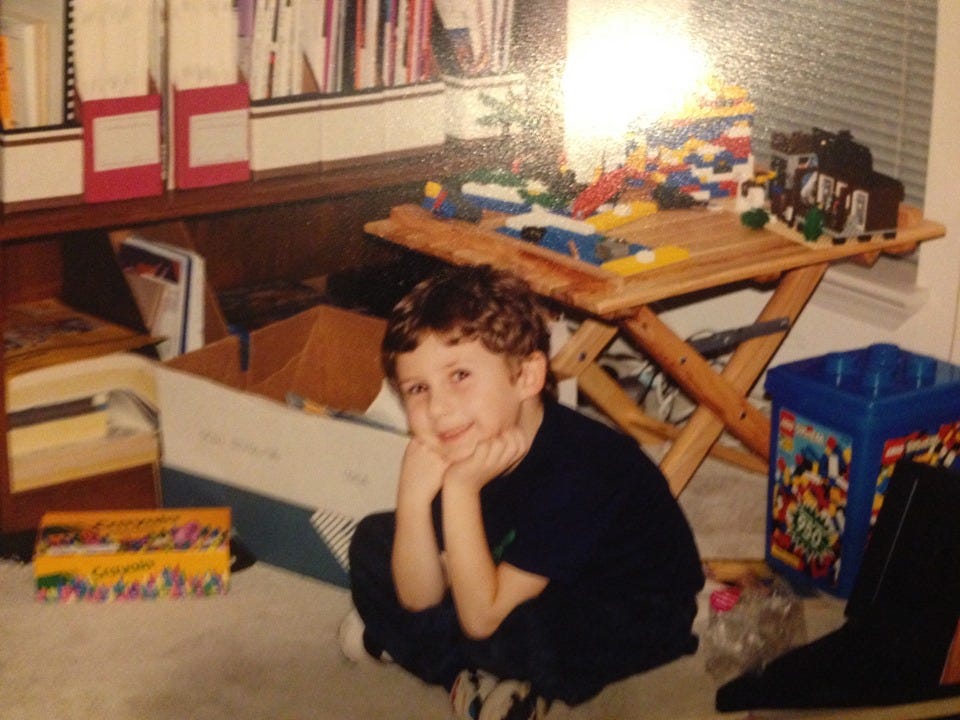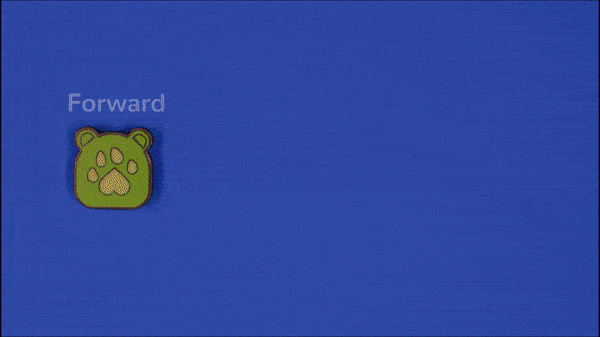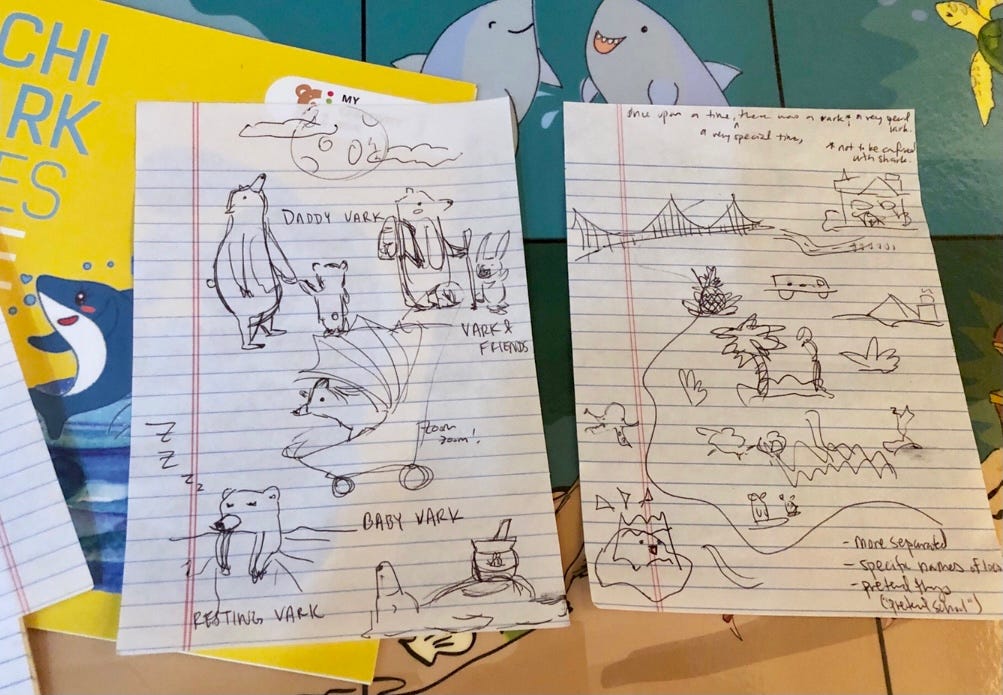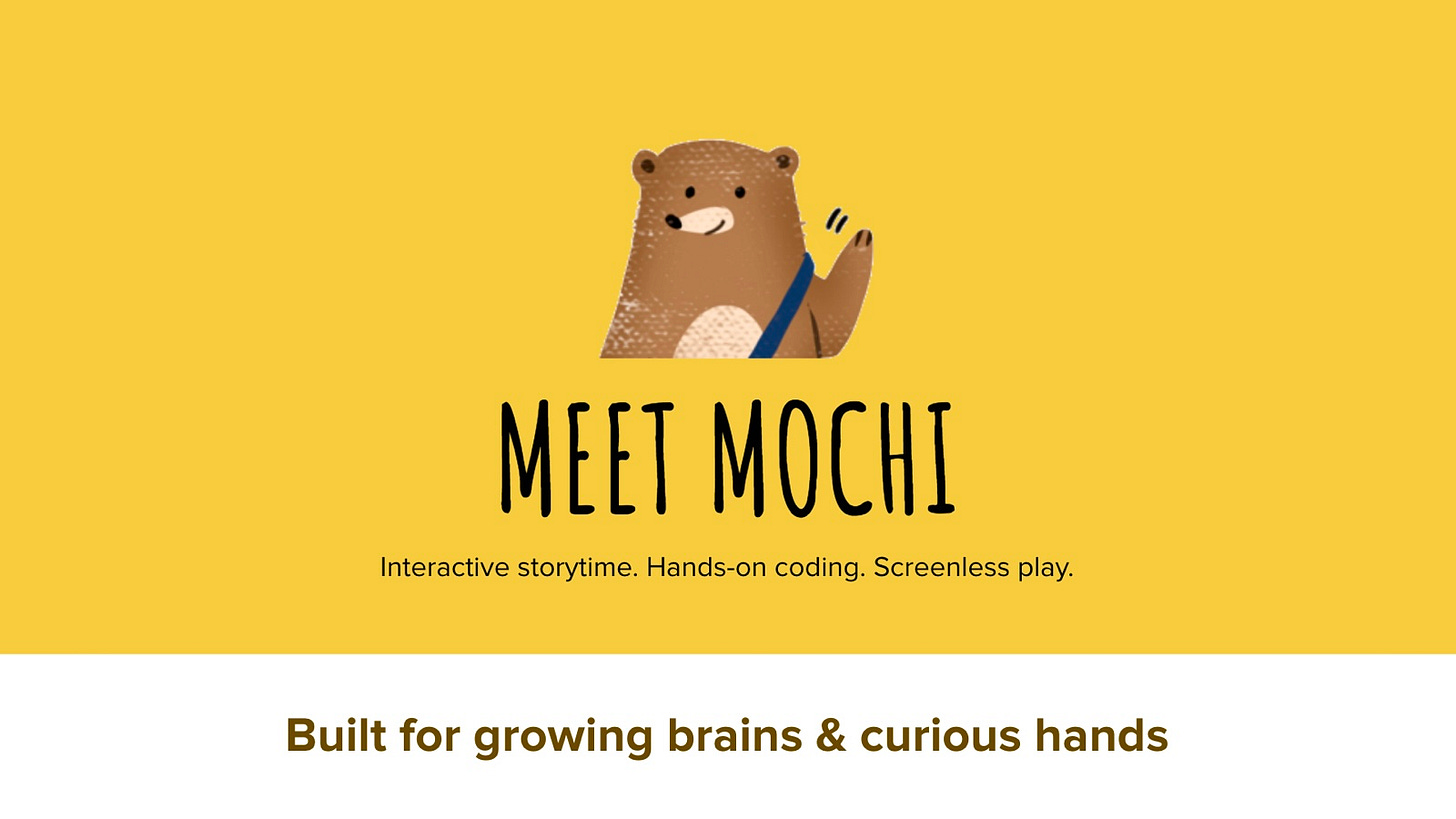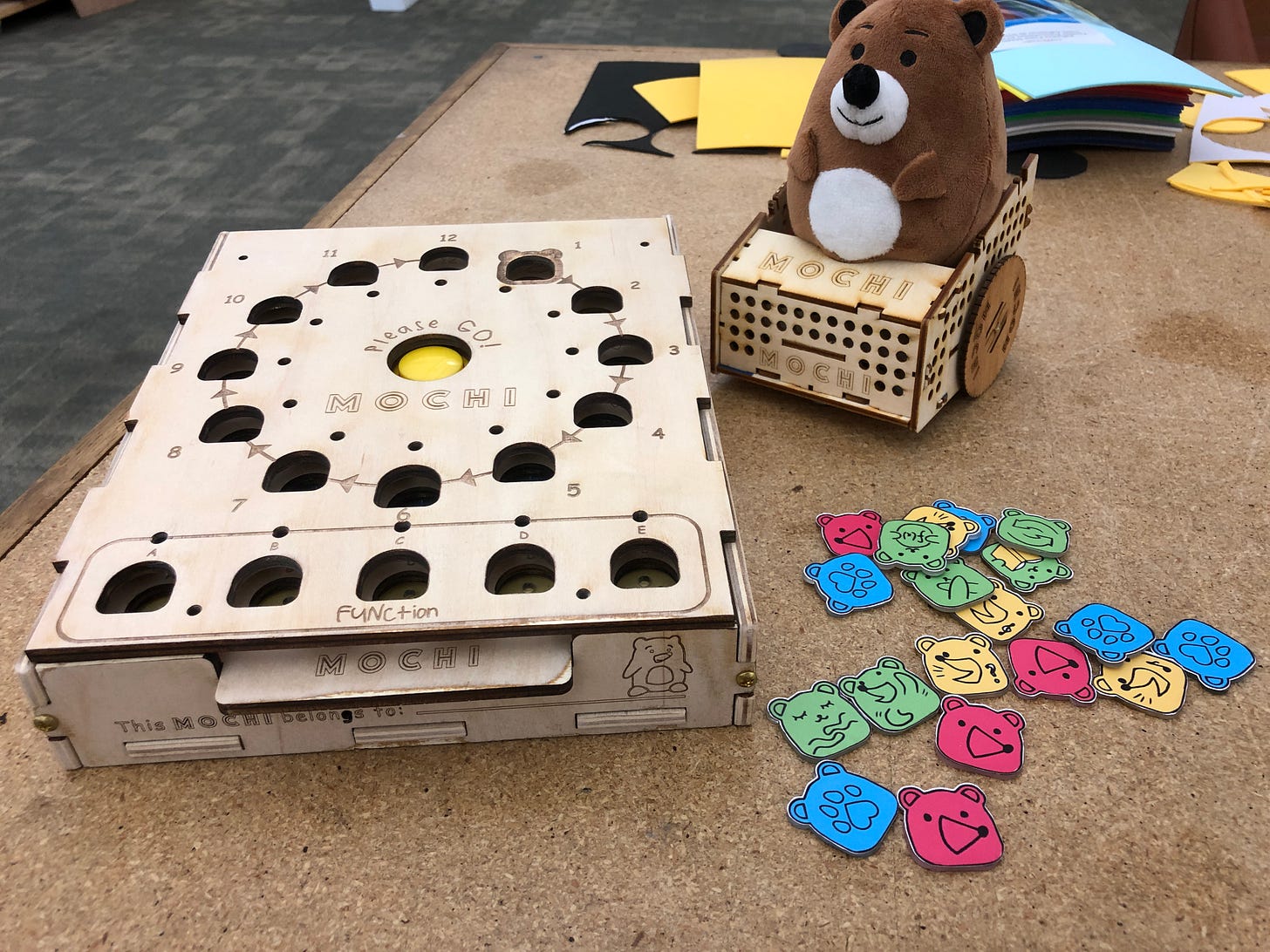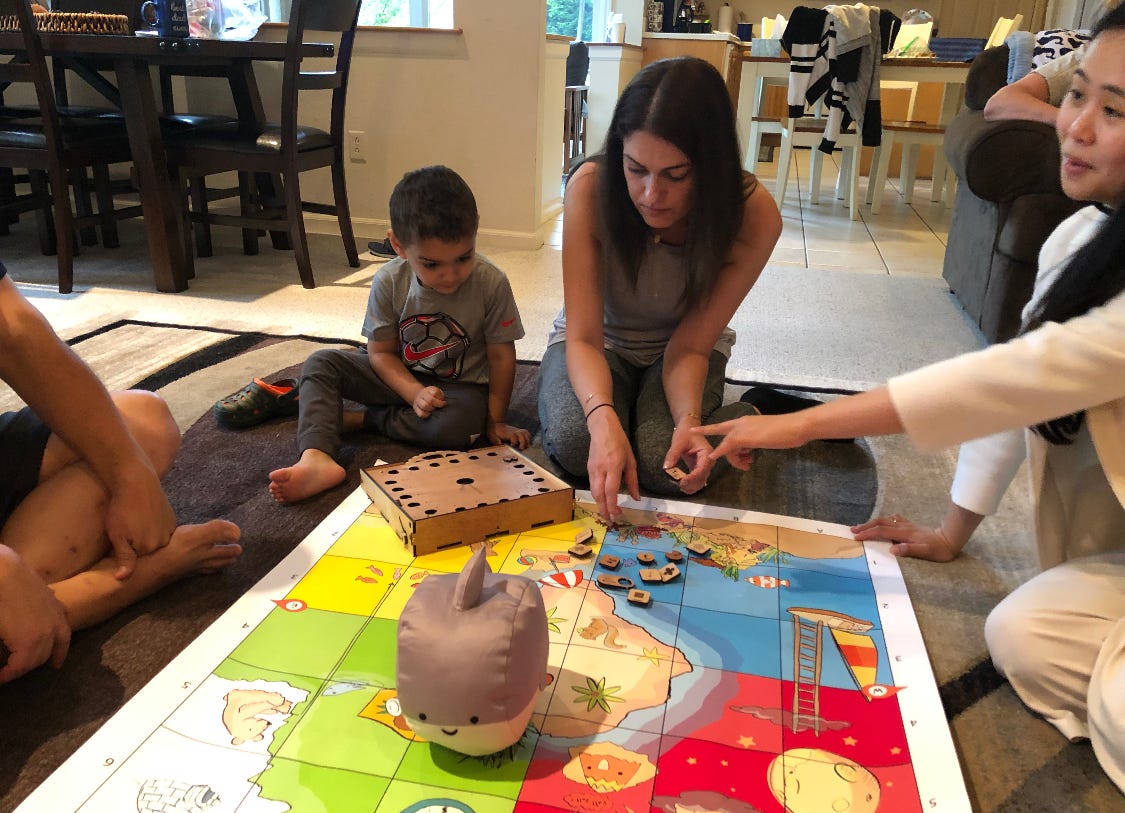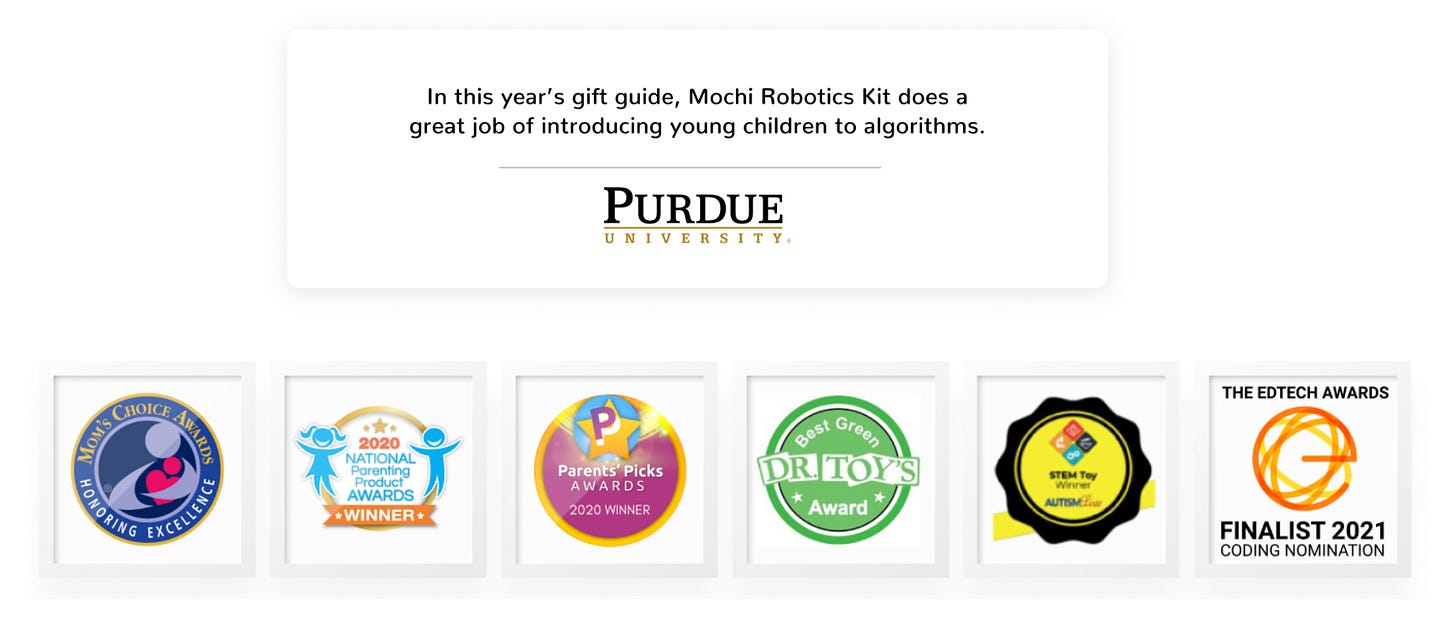Learn With Mochi is a public-benefit corporation that empowers kids of all ages to create with technology. Since 2018, we’ve been building the Montessori method for AI & robotics. Our flagship product, the Mochi Robotics Kit, is a screen-free experience for ages 3+ that teaches computational thinking and creativity through story-based play. This is our story.
Growing up, the world was magical to us.
Every answer led to more questions. Every day was an adventure waiting to be had. Every rabbit hole uncovered something exiting and new. Every discovery unearthed more mysteries. Every road unfolded before us like ribbon, beckoning us to explore.
Daria: One of my fondest memories from this time was playing in the woods by a friend’s parents’ Quebec cottage in the summer. We’d start little campfires to roast marshmallows until they reached the perfect shade of golden brown—then put out the flames just in time before they got too close to the trees. I felt invincible stomping around those forests. We were our own Gods.1
Mark: I have equally fond recollections of my childhood, jerry-rigging Christmas lights in my grandparents’ post-Soviet apartment in Ukraine and taking apart rusty old electronics to give them a second or third life as a new invention. My grandma’s skillful, patient hands taught me that nothing was ever broken; things were just waiting for someone with imagination to come along and turn them into what could be.
We didn’t know it at the time, but this belief—this fervent, irrational exuberance for life—gave us unshakeable confidence in the face of unknowns and a sense of safety we’d carry with us for a lifetime.
With a mindset like that, we were fearless. We approached problems with curiosity and challenges with fervor. No forest was too daunting to explore; no chore too mundane to reveal something new or exciting about the world.
Above all, it made us resilient.
✨ How did we get here?Mark: After getting my undergraduate degree in Biochemistry and Molecular Biology, I thought a PhD program—where I could advance Biomedical Engineering research—would be the best path to impact. But during my first year as a National Institutes of Health (NIH) Scholar at Oxford, I ironically received a medical diagnosis that made me reconsider the timelines I previously simply accepted for my life. It forced me to question what I could accomplish in my lifetime, and on what timescale.
Daria: When Mark and I connected in 2018, I was in a similar headspace. I had quit investment banking in New York and moved to San Francisco to work on IPO investor relations—not a big leap, but a start. It took years to realize I had been asking myself the wrong questions all along: it wasn’t “how do I succeed?” but “what does success mean to me?” I rationalized to myself that I’d never have so little to lose with so few responsibilities. This was the best time to try something new and find out.
We believed that more sinister than the questions we can’t answer are the answers we don’t think to question. What were the implicit assumptions we hadn’t thought to challenge? What was holding us back from contributing to the world in the most values-aligned way we could think of? What are the problems we want to solve? Things about the world—inequitable, unjust, or downright wrong—we want to fix?
We knew we had to do something about it.
🛠️ Why coding? Why now?In 2018, companies like Facebook, Netflix, and Apple were already tremendous wealth-creation machines. It was crazy to us that a couple thousand engineers in Menlo Park could shape how the rest of the world communicates (WhatsApp), stays connected (Facebook), or goes to get inspired (Instagram) — measured in billions of DAUs. We believed Silicon Valley would continue to be the biggest wealth-creation center in our lifetimes.
Paired with the unprecedented speed and scale at which new technologies could be built (in bits and bytes as opposed to blocks and atoms), the answer felt obvious:
Technology is too important to be limited to the 0.01% creating it in Silicon Valley.
What could we do to bring more people into the fold? Whereas old-world institutions derived power from how many people they could exclude (think country clubs, finance jobs, or elite university admissions), we were excited by the promise of technology: that a new definition of power could be derived from how many people we could include.
💪 Encouraging creators, not consumersAt the same time, we saw our nieces, nephews, and friends’ children grow up with iPads, iPhones, tablets, and other sleek, shiny black box devices. It felt like a disservice to kids today that these beautifully designed devices just worked. Instead of the clunky but beloved Commodore 64 that past inventors tinkered with—or, in Mark’s case, jerry-rigged Soviet-era electronics—the carefully curated sleekness of today’s devices masked the inner workings of technology.
It made technology seem like a given—like magic!—as opposed to something kids today can feel empowered to question, create, and shape.
To overcome this, we wanted to design hands-on experiences that empowered any child, anywhere in the world, to make, create, and design the technologies we use every day. We wanted to encourage more creators not consumers of technology.
🤝🏻 Commitment to screen-freeEvery VC on Sand Hill told us it had to be a software play to have worthwhile returns and scale. But as die-hard optimists, we we adamant on hardware for a hands-on experience. After all, a pure software product meant we’d be delivering our solution to kids through the very enemy we were fighting: screen time.
It had to be hands-on or nothing at all. So we persisted.
🧸 How Mochi came to beDaria: The very first Mochi was an aardvark. The defining feature for this character was a long, curious nose. I wanted to bottle up a sense of curiosity and wonder, and share it through our coding products with children everywhere:
Mark: The problem is, we had to educate our customers what an aardvark was! We both grew up with teddy bears. (And Daria still has her’s.) So that’s how Mochi became a curious, brown bear:
Daria: We also wanted the experience to be story-based, to appeal to our innate desire for stories and plot. The product would entail a soft, lovable, and curious brown bear who wants to explore the world and go on coding adventures:
Mark: From my experience building my first company, Play Piper, I knew stories drove longevity with kids. Coding can feel abstract, so we needed a way for Mochi to be intrinsically motivating for kids. That’s how we came up with characters, plot, learning sequences, and a library of coding adventures that builds on prior knowledge:
Daria: In exchange for free office space, I taught STEM classes to local middle schoolers at the Potrero Hill Neighborhood House in San Francisco three times a week. One of my favorite discoveries from this time was seeing how much kids of every age loved tactile learning and play.
So we designed physical coding blocks, inspired by the Montessori method:
Mark: While plastic injection molding is the default way to make toys today, we also resisted the idea of plastic toys. We decided on all-natural wood construction, harkening back to simpler times with simple but timeless toys:
Daria: All original songs, sounds, and audio files were recorded on my phone. Neither of us are voice actors, but we got creative and had a grand time learning how to match sounds to colors, movements, and coding instructions:
Mark: We prototyped by finding family friends who were willing to let us user-test early versions of Mochi in their homes. Between the early mornings and late nights, we spent 100s of hours designing, prototyping, testing, and collecting feedback from dozens of parents, kids, teachers, and families:
Daria: After we had our first working prototypes, we lived in China for several months to figure out manufacturing, supply chain, and logistics:
Mark: After nearly a year of iterative R&D, we moved back to San Francisco to plan our launch. We tapped into my network of product launch experts like Clarissa Redwine, Mihran and Vaneni Vardanyan, and their eloquent, curious daughters:
🌍 Where in the world is Mochi bear today?This Christmas, Mochi bear is turning five!
We’ve been 4 years in the market, 6 years in the making, and shipped to thousands of homes and families in over 60 countries around the world. In the last few years, we’ve even added classroom and STEM certifications, which includes educator training and professional development (PD) to reach more young learners:
Looking back, our favorite moments with Mochi aren’t the sighs of relief when we finally launched, shipped, or got a working prototype. It’s the mountains of customer love, teacher appreciation, and parent feedback Mochi has received — for inspiring growing brains and curious hands.2

And if Mochi bear takes over the world, one classroom, one childhood home at a time?
Well, then that’s perfectly fine by us.
My friend’s parents were refugees from the former Yugoslavia. Although I could barely utter a word in English when I first arrived to Canada from China, they took me in as their own while my parents enrolled in English classes by day and worked odd jobs at night. They taught me generosity can exist even when we have so little. Especially when we have so little.
With deepest thanks to Mark Pavlyukovskyy, my cofounder, for carrying the torch forward and expanding our product vision over the last several and coming years.




